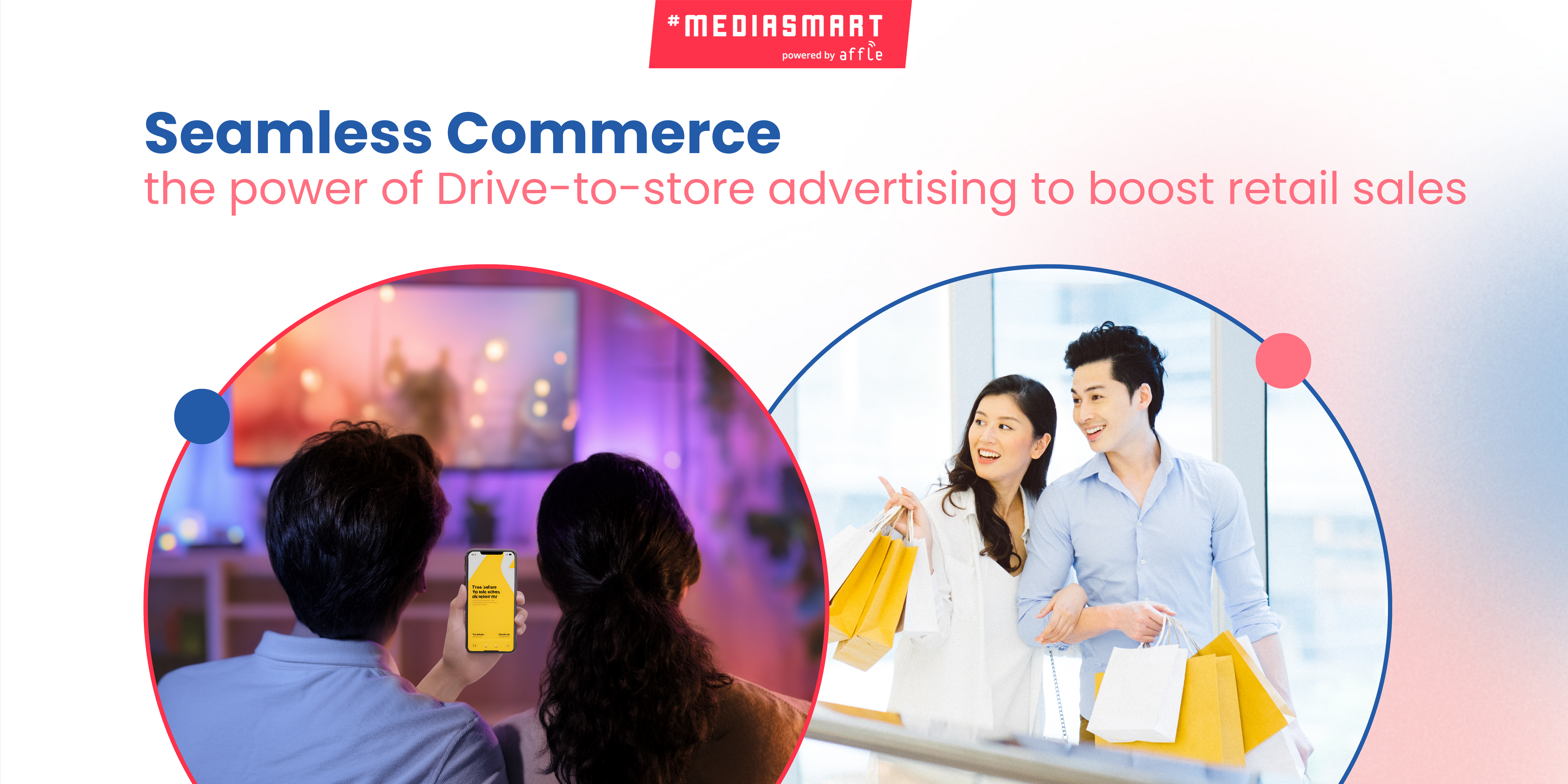Blog
Announcements, analysis and opinions on industry trends around the mobile programmatic world.

Subscribe now, and receive the latest programmatic content directly on your inbox!
Thank you for subscribing to our newsletter
Seamless Commerce: the power of Drive-to-store advertising to boost retail sales

With peak shopping seasons like Back-to-School and Black Friday on the horizon, the digital shift continues to gain momentum. Driven by mobile-first markets like Brazil and Argentina, e-commerce is steadily capturing a larger share of global retail sales, projected to reach nearly a quarter by 2027[1]. Still, the rise of e-commerce doesn't signal the end of physical stores, which account for more than three-quarters of sales globally—it simply means they're evolving to meet new consumer demands. Retail locations are no longer just places to make purchases; they’re transforming into dynamic showrooms that drive brand awareness.
Consumers can transition effortlessly between devices while also moving seamlessly between online and in-store experiences. In Mexico, 69% of spending might be online, but a solid 24% of shoppers still head to stores for inspiration[2]. Brazil’s e-commerce is booming at 14.3% annually, yet 60% of consumers want both online and offline options[2]. The story is the same in the UK and South Africa, where most shoppers prefer an omnichannel approach. India is no different—online spending is projected to maintain its 64% share over the next decade[2], and 77% of consumers still prefer shopping with retailers with digital and physical stores[3]. The buy online, pickup in-store (BOPIS) market is expected to reach $666.2 billion by 2028[4]. And, just between us, have you never pulled out your phone to compare prices online while strolling down the aisle of a major retailer? A whopping 77% of U.S. consumers use smartphones while shopping in-store[4].
Bottom line: seamless commerce is most assuredly the next stage of retail evolution, but while the digital experience is advancing rapidly, attracting customers to physical stores remains a crucial goal for most retailers. That's where drive-to-store advertising comes in—it's all about getting people from scrolling on their phones to walking through the store doors.
You see an ad with a tempting deal on your phone, your CTV, or even on a DOOH screen, and suddenly, you’re thinking, 'Maybe I should head over there.' It is not just about showing a brand up on a screen; it’s about making sure that ad translates into someone walking inside, ready to shop. Let’s explore techniques to help drive store traffic and generate relevant customer experiences.

Reaching customers where they are
By using location data, retailers can send ads to people based on their current location, making the ads more relevant and increasing the chances of a store visit. As an end user, imagine receiving a discount offer on your phone just as you walk by said store—this is the power of geotargeting.
Advertisers have a multitude of available options: targeting particular neighborhoods based on latitude and longitude, zip codes; or even a radius around your best or worst-selling stores. Frankly speaking, getting precise location information could prove difficult owing to how often a device updates its location and consent management. Despite these challenges, using technology that follows 'Privacy by design' principles, location data and geotargeting are powerful tools for attracting nearby customers.
Making the experience unique
Personalized offers are another crucial part of drive-to-store campaigns. Four out of ten consumers are open to receiving personalized discounts and offers for products from brands they haven’t tried[7]. By tailoring promotions to individual shoppers based on their location and even preferences, retailers can increase the likelihood of driving visits to their stores. In the UK, 80% of consumers are open to some form of personalization in marketing communications[7], with a significant portion favoring personalized discounts for products they haven't purchased before. Personalized offers make customers feel valued and more likely to take advantage of in-store deals.
With the right tools, integrating personalized offers into your campaigns is easy. You can use location data, weather data, and contextual targeting to dynamically create ads that change based on the shopper. This approach not only improves the customer experience but also makes your ads more effective.
Connecting across screens
Why stop being relevant to one device when you could be cohesive and relevant across screens? Today’s consumers use multiple devices throughout their day, as shown in the graph below. Cross-screen targeting ensures your ads reach them wherever they are, creating a seamless experience across all their devices. This strategy increases the chances of turning an online ad into an in-store visit.

Cross-screen targeting allows you to create consistent campaigns that follow customers from their first interaction with your ad to when they walk into your store. Ensure you choose the right technology partner to achieve seamless synchronization. I invite you to explore our CTV Household sync and DOOH Audience sync solutions. On top of that, using tools like click-to-map URLs or interactive map ads can further boost the effectiveness of your campaigns by helping customers find your nearest location.
Incremental drive-to-store
Drive-to-store advertising is a secret weapon that connects digital impressions with real-world foot traffic, driving potential customers to visit physical stores. Think of it as the bridge between the online and physical worlds—where you see an ad pop up and then you’re thinking, "Yeah, I should go check that out in person". It is seen as a great avenue to measure closed-loop attribution. This approach tracks sales outcomes back to specific ads, which 57% of advertisers in Europe[8] identify as a major opportunity.
Footfall can be measured through in-store actions, like app interactions, or by tracking location data via GPS, beacons, SDKs, and bidstream analysis, each with its strengths and challenges. mediasmart uses location-prompted visits for their ease of measurement, but the real value comes from our proprietary incremental metrics methodology.

Assuming that everyone near your store is there because of your ad is tempting, but we both know that’s not always the case. You need to dig deeper to understand how well your drive-to-store campaign is performing. So rather than just counting attributed visits—people who happen to be near your store after seeing an ad—we measure the true effectiveness of a campaign by comparing the behavior of users who saw the ad with those who didn’t, isolating the increase in visits directly caused by the campaign. Real-time optimization further enhances this strategy by blocking users who have already visited the area and focusing on finding lookalikes, ensuring that the campaign reaches new potential customers and maximizes foot traffic.
The smart wrap-up
Drive-to-store advertising is a powerful way to boost in-store traffic and sales. By using location data, personalized offers, cross-screen targeting, and measuring incrementality you can create and measure impactful marketing. These strategies not only help bring more people into your stores but also offer a more personalized and engaging shopping experience.
Don't let potential customers pass you by, contact us to start today!
Sources
[1] Global e-commerce share of retail sales 2027 | Statista
[2] The Future Shopper 2023 report | MMA Global
[3] Towards seamless commerce report | KPMG
[4] Retail Industry Trends in 2024 | Mastercard Data & Services
[5] Digital Media Trends 2024 | Deloitte
[6] 35 E-Commerce Statistics of 2024 | Forbes
[7] Customer Engagement: Future Trends 2024 | DMA
[8] Attitudes to Retail Media 2024 | IAB Europe
[9] Digital 2024: Global Report | DataReportal
Topics: footfall, drive-to-store, cross screen strategy, ctv measurement
%20(1).jpg)
